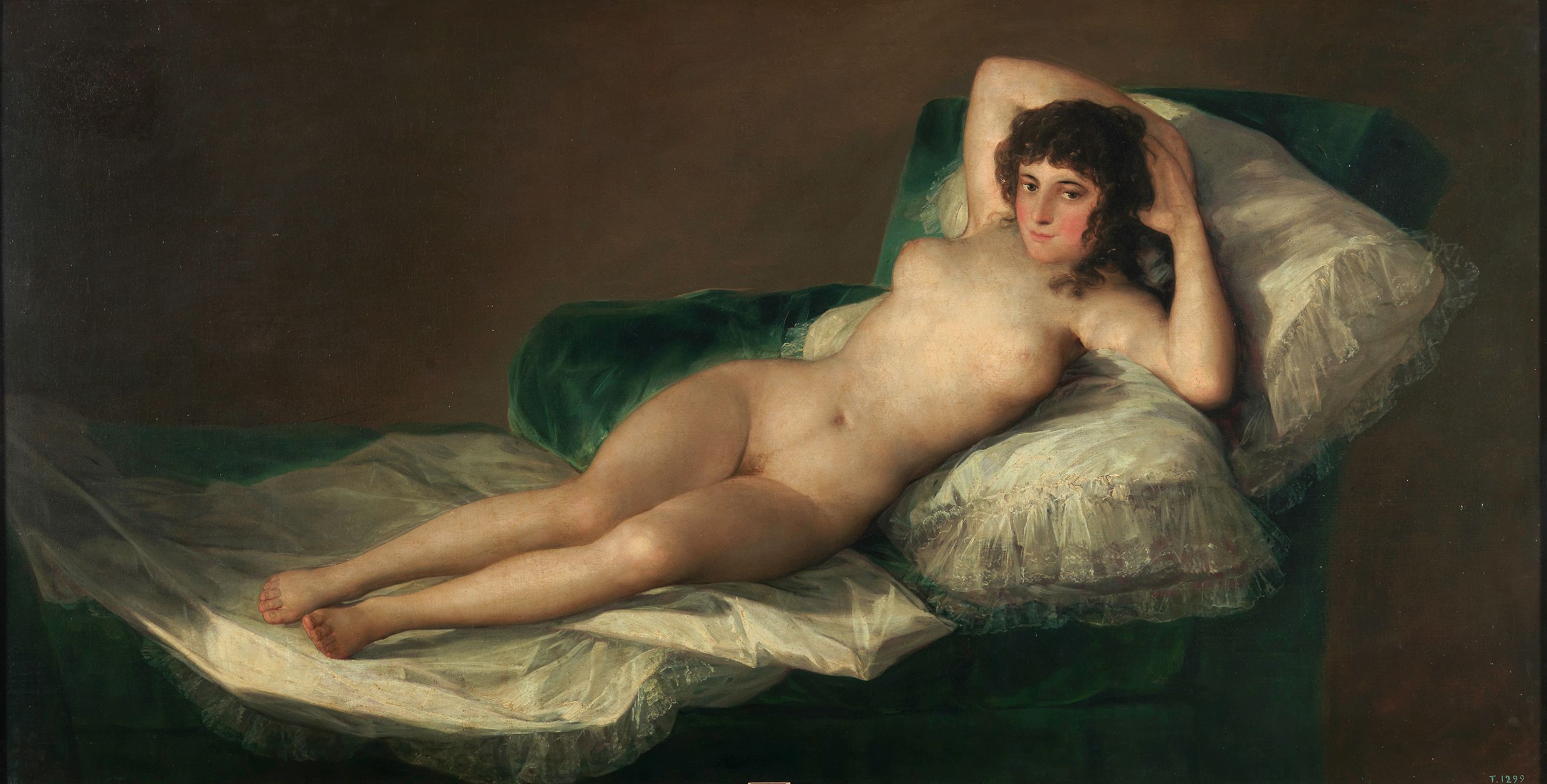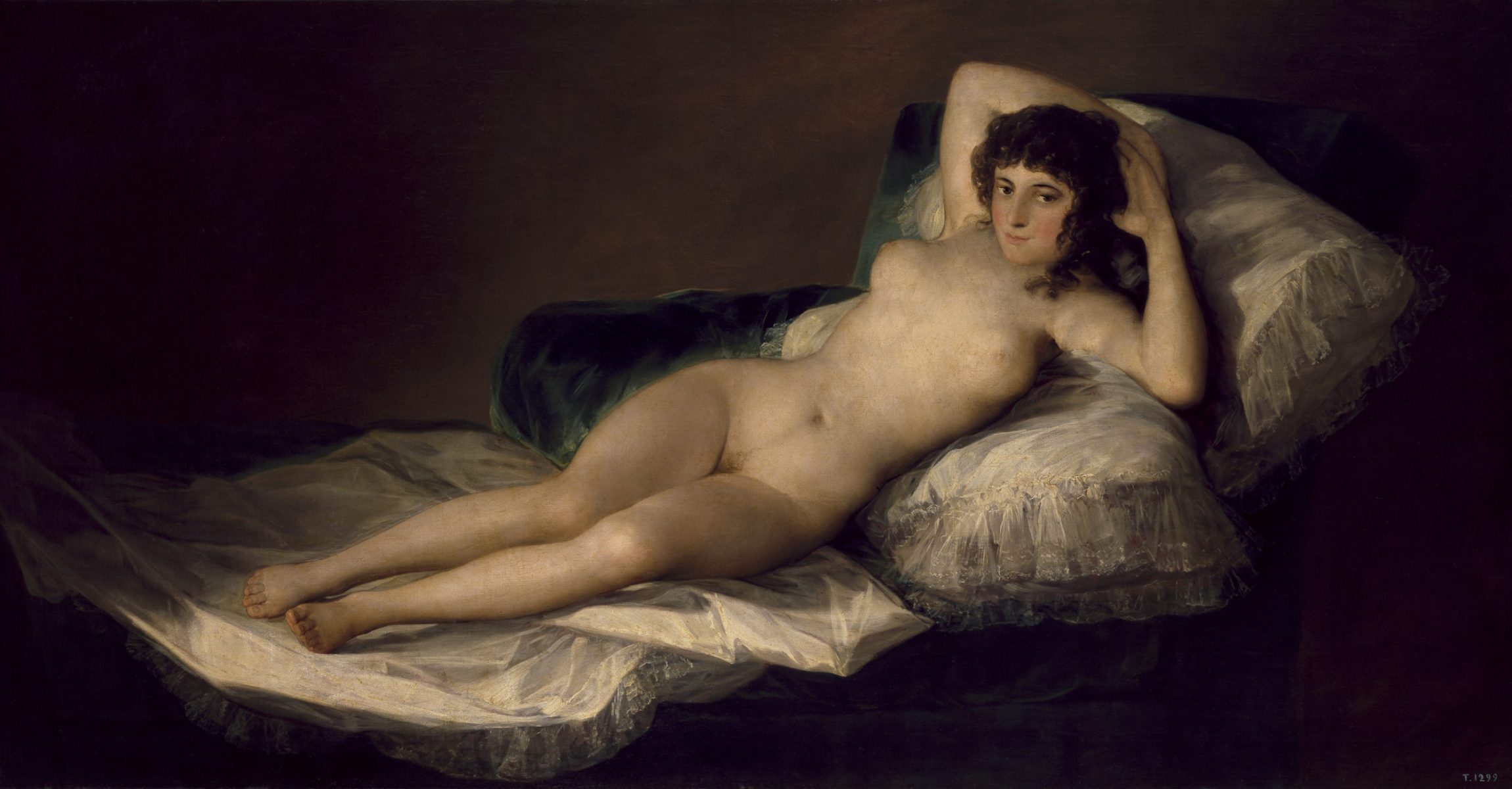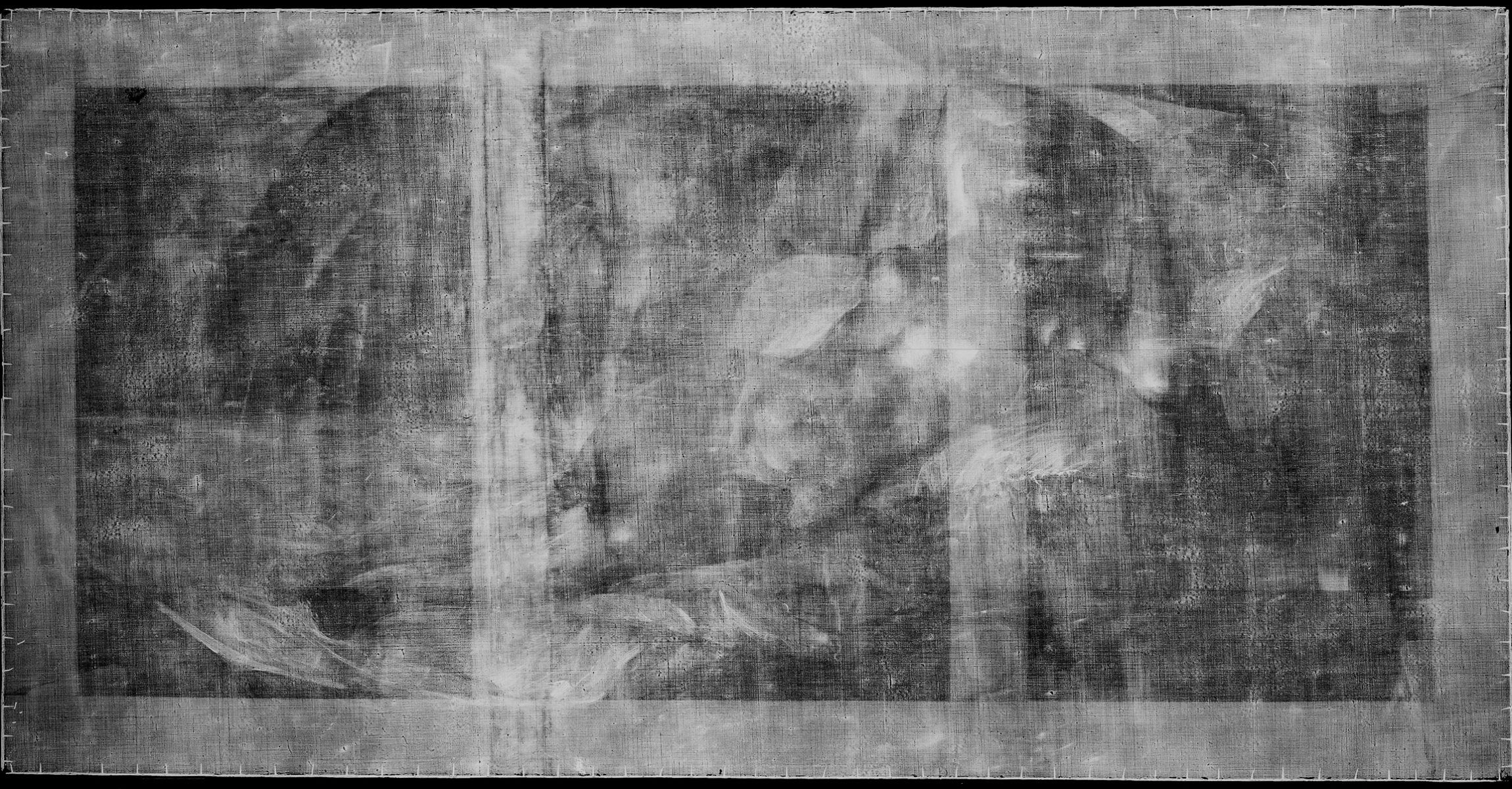It is widely believed that his lover, the Duchess of Alba, posed for the artist for the paired masterpieces “Maja Dressed” and “Maja Naked.” We figured out how plausible this legend is.
The story that Francisco Goya painted the Duchess in the nude is widespread. It serves as one of the cross-cutting plots of Leon Feuchtwanger's novel "Goya, or the Hard Path of Knowledge" (1951), its Soviet-German film adaptation (1971) and other films, for example “Mach Nude” (1958), other works of art and publications on the Internet. This identification is ancient: already in 1843, Louis Viardot, who saw “Maja dressed” at the Royal Academy of San Fernando, wrotethat in 1802 "it was believed that she portrays the Duchess of Alba."
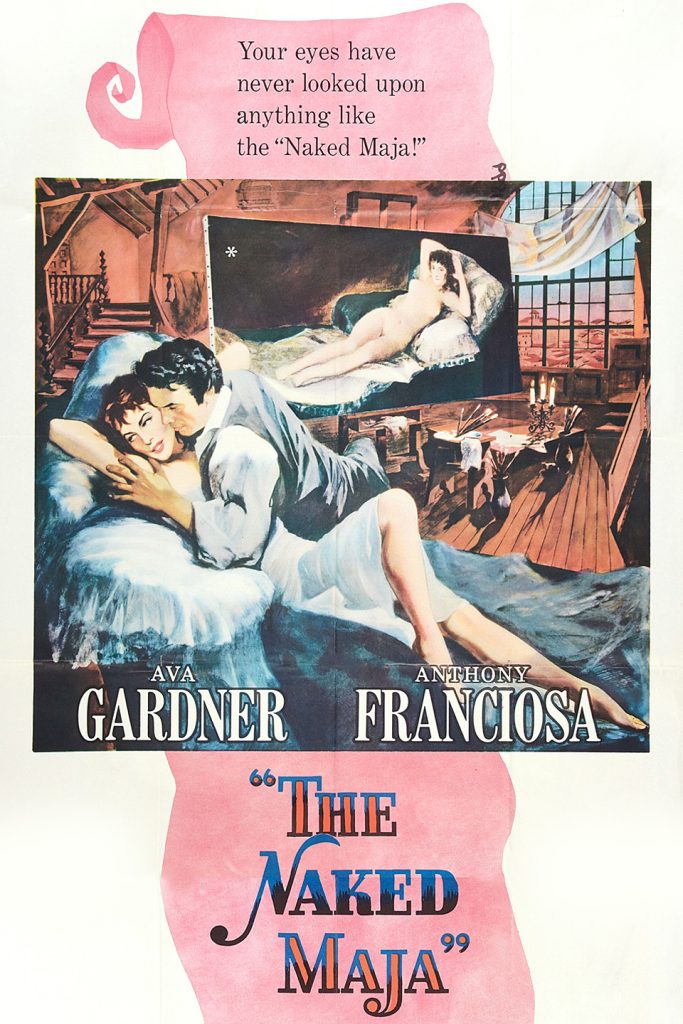
This legend is based on the assumption of a close relationship between the artist and the aristocrat. Encyclopedic Dictionary of Artists' Models leads both "Mach" in Goya's list of paintings associated with the Duchess. It also included “Portrait of the Duchess of Alba in a White Dress” (1795) and “Portrait of the Duchess of Alba” (1797), as well as the so-called “Sanlucar Album”.
In the first of these portraits, the Duchess of Alba appears in the dress of a maja (a Spanish dandy of the lower class, whose costume was worn in that era it was fashionable among the patriotic aristocracy). She points with her finger to a barely visible inscription in the sand: “To the Duchess of Alba Fr-co de Goya 1795.” That same year, Goya painted an informal painting, depicting the duchess quarreling with her duenna Beata. Goya also managed to write two portrait the duchess's husband, who died in the summer of 1796.
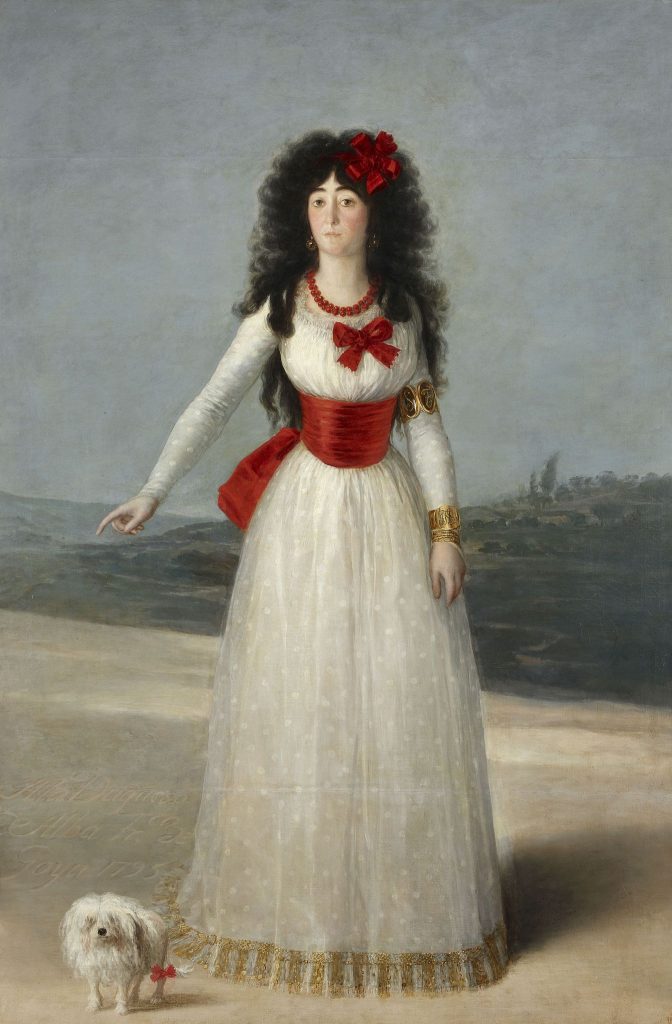
Goya Collection (Spain)
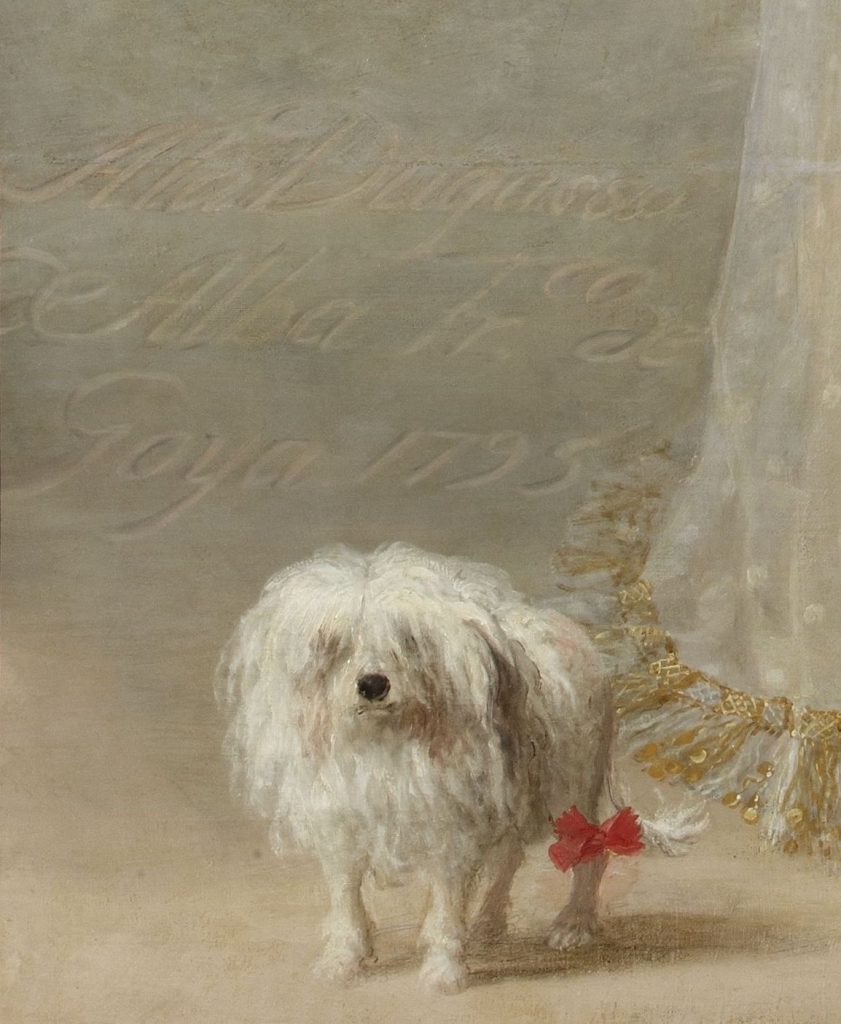
The duchess spent the period following the death of her husband at the Sanlúcar estate, where went in Goya's society — he lived there for several months. In Sanlúcar, the artist created an album with drawings in which one can find very intimate scenes: a certain black-haired woman plays with a little black-haired boy (it is known that the Duchess took custody an African girl named Maria de la Luz), puts on stockings, combs her hair, and lifts up her shirt. "Sanlúcar Album" by many counts one of the main pieces of evidence that there was an intimate relationship between the artist and the duchess - at least for several months.
The second evidence of this relationship is considered to be the “Portrait of the Duchess of Alba” (“The Duchess in Black”), where she is also depicted in a mahi dress, but in black. The Duchess wears two rings on her right hand, one written "Alba", on the other - "Goya". Her finger, as in the previous portrait, points to the autograph in the sand. Moreover, the restoration was from the 1950s showed, that in fact it says not just “Goya”, but “only Goya”. The first word was painted over by the artist himself. Unlike the first painting, it did not end up in the collection of the Dukes of Alba — Goya kept it for himself until 1812. These inscriptions prove that even if there was no intimate relationship between them, then at least Goya was definitely very much in love.
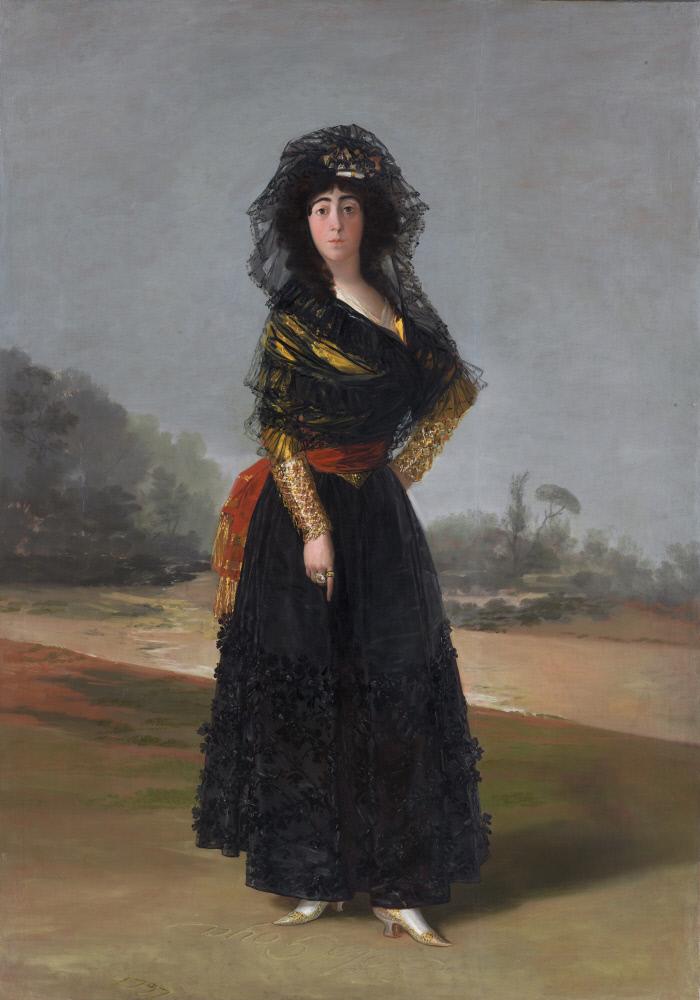
Hispanic Society of America (USA)
Although in both of her oil portraits the Duchess of Alba is depicted wearing a maja, if we talk about Goya’s work, this was not her exclusive attribute. In the Spanish national costume, Goya painted not only the Duchess of Alba, but also the queen Maria Louise, as well as the Countess Fernand Nunez. He also has genre paintings with swings - "Swing on the Balcony", "Paseo de Andalucia", "Manola (La Leocadia)", "Comet", as well as numerous graphics.
The version that the Duchess of Alba posed for the diptych with her clothed and naked arms faces several contradictions, as scholars of the artist's work admit. The main one is that the duchess’s face, as we know it from portraits, simply does not coincide with the appearance of the makha. In particular, the unknown nude looks younger, although they are both brown-eyed, curly brunettes. “The widespread assumption that Goya rewrote her head to hide her true facial features has been refuted by a recent X-ray, which shows that the entire body was painted at once and there is no noticeable change in the figure,” reports Prado catalogue.
The second problem is the extremely high social position of the Duchess of Alba (by the way, she inherited her title from her grandfather, and did not acquire it through marriage). Posing completely naked for a portrait, with such an indecent detail as pubic hair, would be an incredibly shocking act for such a high-ranking aristocrat. A pencil sketch in an album is one thing, a large-format painting is another. Portraits “in the image of Venus” were indeed common in European art, but the peak of their popularity had to for the 17th and first half of the 18th centuries. It was mainly French aristocrats who posed in the image of the goddess of love, but even among them few dared to appear completely naked - noble ladies were painted in “tunics.” When in 1808 the sister of the French emperor Pauline Bonaparte was depicted half-nude by the sculptor Canova in Venus Victorious, it turned around scandal. In the 19th century, only ladies of the demimonde would pose for portraits in the image of Venus, courtesans.
The third problem is that the Duchess is a Spanish aristocrat, and Goya is a Spanish artist. In Spain, unlike Italy, France or the Netherlands, due to the control of the church existed a colossal taboo on the depiction of nudity. None of the Spanish artists, starting from the Renaissance, dared to paint it under pain of excommunication, fine or expulsion. At the same time, the Spanish kings bought nude works by foreign painters, such as Titian and Rubens, but did not show them publicly. Paintings were stored in special rooms in royal palaces, the so-called salas reservadas, where monarchs retired to “rest.” Only special guests could see the masterpieces in these rooms. Salas reservadas survived in aristocratic Spain for more than two centuries, until 1838. And the first (and, apparently, for many years the only) Spanish artist to paint a nude woman was Diego Velazquez, who created "Venus with a Mirror". And then, most likely, he did this while in relaxed Italy. Another rare exception is Velázquez's successor as court portrait painter, Juan Carreño de Miranda, who around 1680 created a diptych with the same concept as Goya - the image dressed And undressed women. However, this double portrait of Eugenia Martinez Valleja, probably known to the author of “Mach,” depicted not a beauty, but a court dwarf, a “monster,” and therefore was classified not as eroticism, but as “curiosities.”
It is assumed that it is precisely because of this legislative Catholic hypocrisy that there are two “Mach”: at first a nude was painted (1795–1800), and Then, a few years later, - dressed (1800-1807) so that it could be used as a "cover". With a similar, protective purpose for his "The Origin of the World" Courbet wrote landscape with a village church. By the way, in terms of the effect that “Macha Nude” had on Spanish society during the time of Goya, it can be compared with the scandalous painting by Courbet.
The concept of salas reservadas is important for the history of "Maja Nude", because for the first time this painting mentioned in 1800, in a description of just such an “intimate” room (el gabinete reservado). Only not royal, but belonged to Manuel Godoy - the all-powerful favorite, who actually ruled Spain at that time. In addition to the two “Machs” (by the way, they were then called “Venuses”), Godoy hung there the same legendary “Venus with a Mirror” by Velazquez and two other nudes attributed to Titian. Goya worked a lot for Godoy: in 1794 he wrote his equestrian portrait, in 1801 - a ceremonial portrait in a general's uniform, and in 1800 captured his wife, Countess of Chinchon.
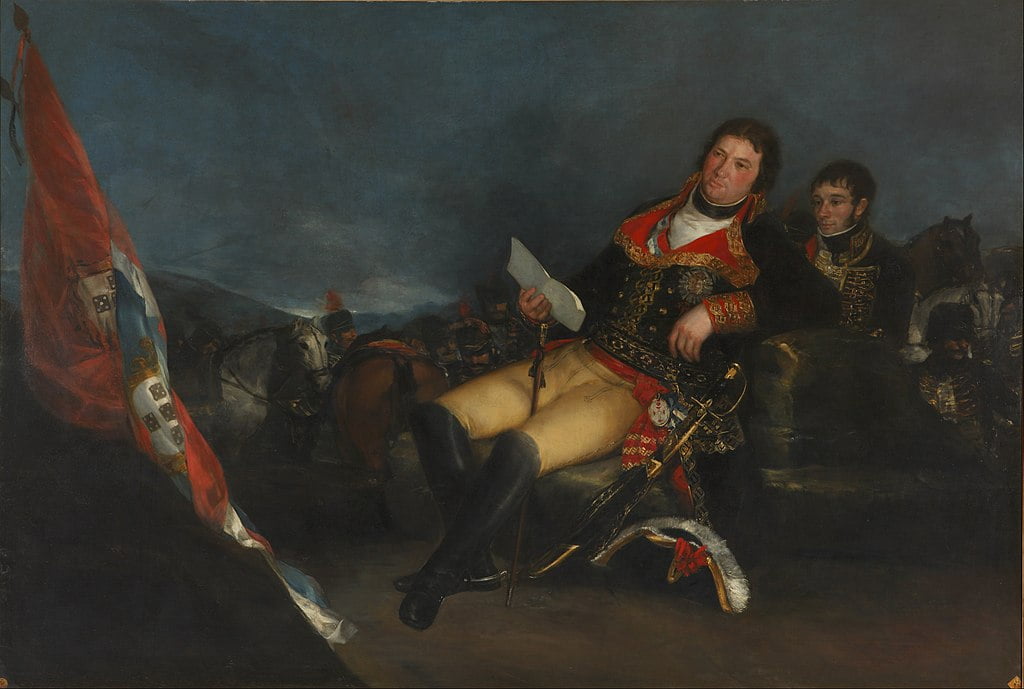
Royal Academy of Fine Arts of San Fernando (Spain)
Goya biographer Richard Schickel emphasizes, that it was Godoy “who was an influential enough person to ignore the ancient ban on depicting the naked body” and make such a secret order to Goya. But the Duchess of Alba, who was at enmity with the royal court, would not have been able to protect the author of such a dangerous painting and would have risked it herself by giving such an order.
In Feuchtwanger's novel the Duchess speaks Goye: “I want to order you, Don Francisco, two portraits of myself, one in the costume of a maja, the other in the form of a maja as it is.” This is the writer's invention. There is no evidence that the Duchess commissioned these two paintings. Moreover, it is difficult for a specialist to imagine a situation in which a woman would do something similar, based on the realities of the time. On the contrary, for the life-loving Manuel Godoy, known for his promiscuity, such an order with the aim of decorating his personal, men’s quarters seems natural. He hunted for nudes: it is known that the mentioned “Venus with a Mirror” by Velazquez was in that period (before 1800) sold Its owner was the same Duchess Alba. Finally, the artist's son Javier Goya around 1830 right indicatedthat my father wrote Venus for Godoy.
The Dictionary of Artists' Models cites a rumor that the Duchess of Alba and Godoy were lovers, but this not very plausible: The duchess was an enemy of the queen, Godoy's patron and presumably mistress, to whom he owed his power. Godoy would not have commissioned a portrait of Alba, also because it would have offended the queen. And Goya, with his difficult character, would not have painted a portrait of a woman with whom he, apparently, was in love, for her new gentleman.
In the English version of the article about the “Mach Nude” on the official website of the Prado Museum reported: "Legend has it that she is the Duchess of Alba, but the sitter has also been identified as Pepita Tudo, who became Godoy's mistress in 1797." Josefa de Tudo (1779–1869) was the daughter of a provincial nobleman, she remained Godoy's official favorite for many years, despite his numerous mistresses and his official wife, the Countess de Chinchon. At the request of her lover, the king granted her the title of count. Tudo bore Godoy two children, and in early 1829, after he was widowed, they got married.
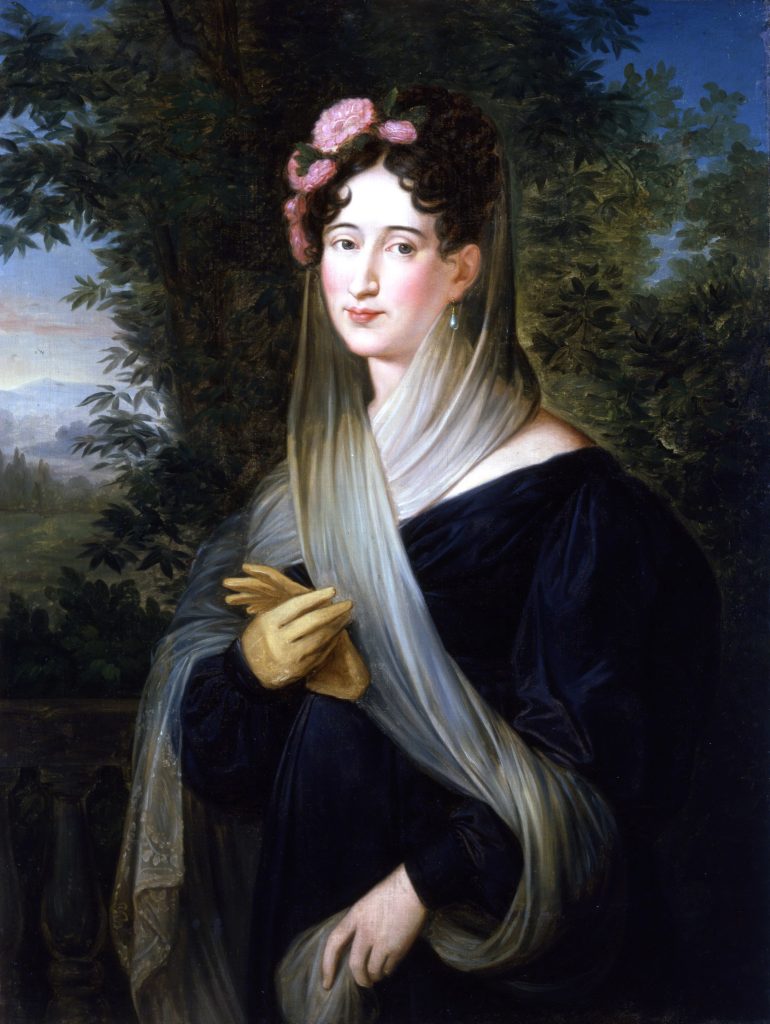
Royal Academy of Fine Arts of San Fernando (Spain)
Reliable portraits of Tudo were made by artists of the second rank and cannot serve to identify “Mahi”. But at least they show that she was also a brunette with regular facial features. The version that Tudo posed for “Mach” is also arose in the 19th century (it is in the Prado catalog of 1872), but gained less popularity. There is also no evidence that the painting depicts Tudo, although from the point of view of her frivolous position in the late 1790s it looks much more plausible. In addition, Tudo was about 18 years old at the time of writing “Maja Nude”, and the Duchess was already under 40 and she was serious was sick, the body on the canvas is young.
Because of the Napoleonic Wars, Godoy fell, and then the Inquisition reached out to his indecent collection of “nudes.” The British managed to take Velazquez out, but "Mahi" on November 28, 1814 were transferred at the disposal of the Inquisition tribunal, where they remained until 1836. Online for this occasion writethat Goya allegedly said at the trial: “I am not revealing who the model was for the painting, because the scandal would be much bigger.” But it's just another legend. In fact, on March 16, 1815, the Privy Chamber of the Inquisition of Madrid ordered, so that Goya, as the author of one of the five obscene paintings from this collection, “appear before this tribunal so that he can recognize them (the paintings - Ed.) and declare whether they are his work, for what reason he made them, on whose behalf, for whom and for what purposes were they intended.” However, no subsequent documents related to this story, as report researchers have not survived; it is not even known whether Goya gave any testimony on this matter at all.
There is also a claim on the Internet that in 1945, in order to refute the version of the duchess posing for an “indecent picture,” the then Duke of Alba ordered her tomb to be opened in order to measure the duchess’s bones and prove that her proportions (and the length of the bones) do not coincide with the proportions of “Maja.” But since the grave had already been opened, and the duchess’s body was thrown out by Napoleonic soldiers, it was not possible to take measurements in its current state (the long bones were broken). However, medical historians reportthat the Duke gave his commission not because of the painting, but to refute the accusation that his relative was poisoned by the Queen of Spain. The leg bones were indeed damaged, but for a different reason: the coffin was already short initially, and the feet of the body were sawed off so that it could fit into it.
Luis Garcia Gomez in his article 2014 reports that although the grave was indeed opened on April 17, 1945, the remains were found in a condition acceptable for examination. Three doctors who examined the duchess's bones determined that she had suffered a serious spinal deformity (scoliosis) on her right side, which would have made her right shoulder appear higher - apparently why Goya painted her half-turned in two full-length portraits. On the contrary, both “Mach” shoulders are fine, but they have an abnormally wide distance between the chests and an abnormal disproportion between the waist and the length of the legs, like writes Arthur Lundquist.
How sums up researcher Marie Louise Crumrine in a 1994 article: “There is no evidence that the paintings ever belonged to the Duchess of Alba, and even less evidence that they depict her.” Modern researchers believe that, most likely, the diptych with swings was created for Manuel Godoy to add to his collection of frivolous paintings. Perhaps the model for the maja was his mistress Pepita Tudo, or any other young girl of dubious social status who was not afraid to pose naked. Or her appearance was created by Goya from his head by combining the images of several women. Prado's official position at the moment is not to indicate any exact names of the sitters.
Most likely not true
- J. Tomlison (ed.). Goya: Images of Women
- I. Shank. How Spain's Kings Hid Thousands of Nude Paintings from the Catholic Church
- La Autopsia De La Duquesa De Alba
If you find a spelling or grammatical error, please let us know by highlighting the error text and clicking Ctrl+Enter.


